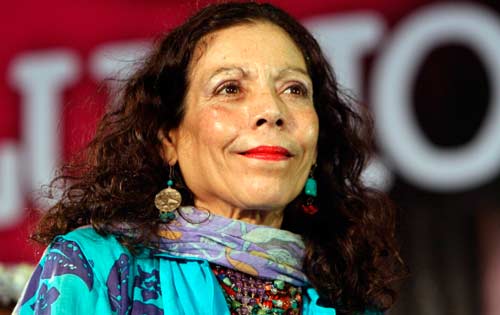Rosario Murillo, Nicaragua’s Powerful Vice President
By Gabriela Selser (dpa)

HAVANA TIMES – At 65, Rosario Murillo is considered Nicaragua’s most powerful woman. Poet, writer, and exclusive spokesperson for the government, she’s reached the office of Vice President of the Republic at the hands of her husband, Daniel Ortega.
The Ortega-Murillo formula won the elections this past November 6th with 72.5% of the votes, according to the official general election results. The elections were held with no real opposition or independent observers.
Ortega, 71, was reelected for a second time as the candidate for the governing Sandinista National Liberation Front (FSLN), thus initiating his fourth presidential term and third consecutive one on January 10th.
Born in Managua in 1951, Murillo opposed the dictatorship of Anastasio Somoza as part of the “Gradas” [“Steps”] cultural group, made up of artists who would meet in the church courtyards during the convulsive decade of the 70s to demonstrate their opposition to the regime.
She served as secretary to Pedro Joaquín Chamorro, the assassinated director of the “La Prensa” newspaper, and in 1977 met Daniel Ortega while in exile in Costa Rica. Following the triumph of the revolution (1979-1990), while her husband governed the country, she led the Sandinista Association of Cultural Workers (ASTC).
Mother of nine, seven of them with Ortega, “compañera” Rosario has been gaining power since the Sandinista leader was returned to power in 2007, following 16 years in the opposition.
Since that time, as “coordinator of the Council for Communications and Citizenry” she’s been the only government spokesperson. She leads the cabinet meetings, coordinates emergency plans and special health campaigns, and organizes in detail all governmental ceremonies.
It’s been affirmed that the principal Government slogans, which combine leftist jargon with religious phrases, have been the work of this powerful woman, whose daily talks over the official broadcasting networks invoke God, the Virgin and all the saints.
Decked out in colorful gowns with abundant rings, bracelets and necklaces with “good luck stones”, the first lady has been judged Nicaragua’s “most popular” personality in the polls, although it’s been said that within the FSLN there are many Sandinistas who oppose her.
Analysts consider that she was chosen as the Vice Presidential candidate to “assure a succession” in case Ortega – who has been suffering from an undisclosed illness for years – can’t complete his five years in the government.
It’s the first time in Nicaragua that a married couple has occupied the two highest seats of power. In addition, seven of her children maintain investments, private businesses and a dozen radio and television stations in the country.
In Latin America, it recalls the case of Juan Domingo Perón anjd Isabel Martínez, inaugurated in 1973 as Argentine President and Vice President. Following Perón’s death in 1974, Martínez took over the government until she was deposed by a coup d’etat in 1976.
In addition to the seven children she had with Ortega, Murillo had two others from a previous relationship. One of them, Zoilamérica Narváez, in 1998 accused Daniel Ortega, her stepfather, for rape and sexual abuse dating back to when she was an 11 year-old child. The legal proceedings were blocked when Ortega shielded himself with the political immunity he enjoyed as a deputy in the National Assembly.
In political circles, it’s affirmed that the enormous power wielded by the first lady is precisely the fruit of the absolute backing she gave her husband during the scandal. She publicly opposed her biological daughter, who today lives in virtual exile in Costa Rica with her Bolivian companion who was expelled from Nicaragua in 2013.





